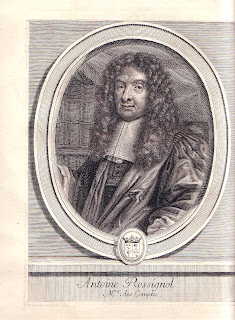
When one from Amboise* and youself, by an admirable success
Severally make our peoples rejoice,
Allow me to compare to your unprecedented deeds
Those of this great prelate**, without you incomparable.
He wore like youself the venerable purple
Of which the holy radiance our eyes bedazzle,
He, like you, kept watch with a care indefatigable,
He thus became like you the heart of a King LOUIS.
He like you travelled the mountains in arméd might.
He knew as well as you how to transform to smoke
The pride of enemies and to return their blows.
A single aspect of you two formed a difference.
It is that he was formerly to France the Pope’s legate,
While France had wished to make an envoy of Rome of you.***
- written after 1662 -
* Maréchal Antoine d'Amboise 1605-1650.
** Cardinal Jules Mazarin 1602-1662, Richelieu's successor.
*** Pope Urban VII had refused to make R Papal Legate to France
Celebration at the Peace of the Pyrenees 1659
when the 'hexagon' of modern France was established.
À
Monseigneur le Cardinal de
Richelieu
Sonnet
Puis qu'un d'Amboise & vous d'un succès admirable
Rendez également nos peuples réjouis,
Souffrez que je compare à vos faites inouis,
Ceux de ce grand Prélat, sans vous incomparable.
Il porta comme vous la pourpre vénérable,
De qui le saint éclat rend nous yeux éblouis;
Il veilla comme vous d'un soin indefatigable;
Il fut ainsi que vous le coeur d'un Roi Louis.
Il passa comme vous les monts à main armée,
Il sçut ainsi que vous convertir en fumée
L'orgeuil des ennemis & rabattre leur coups:
Un seul point de vous deux forme la différence.
C'est qu'il fut autrefois Légat du Pape en France
Et la France en voudroit un envoyé de vous.

Qu'on parle mal ou bien du fameux Cardinal,
Ma prose ni mes verses n'en diront jamais rien;
Il m'a fait trop de bien pour en dire du mal,
Il ma fait trop de mal pour en dire du bien.
As to whether one speaks well or badly of the famous Cardinal,
Neither my prose nor my verse ever speak anything of him;
He has done me too much good to speak of him badly,
He has done me too much harm to speak of him well.
Pierre Corneille (b. Rouen, 6 June 1606 - d. Paris, 1 October 1684) is a 17th century French dramatic author. His most famous plays are Le Cid, Cinna, Polyeucte and Horace. The wealth and diversity of his works reflect the the values and cultural questions of his day.


















